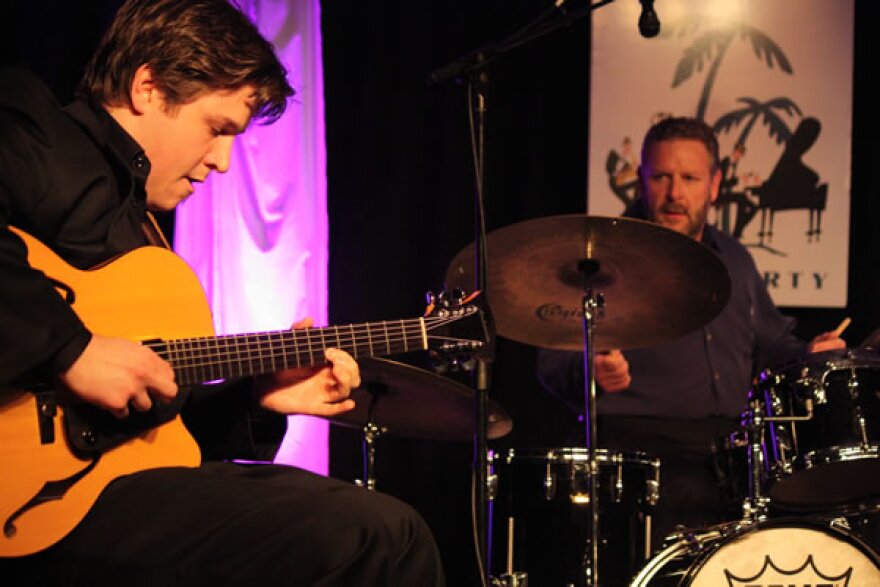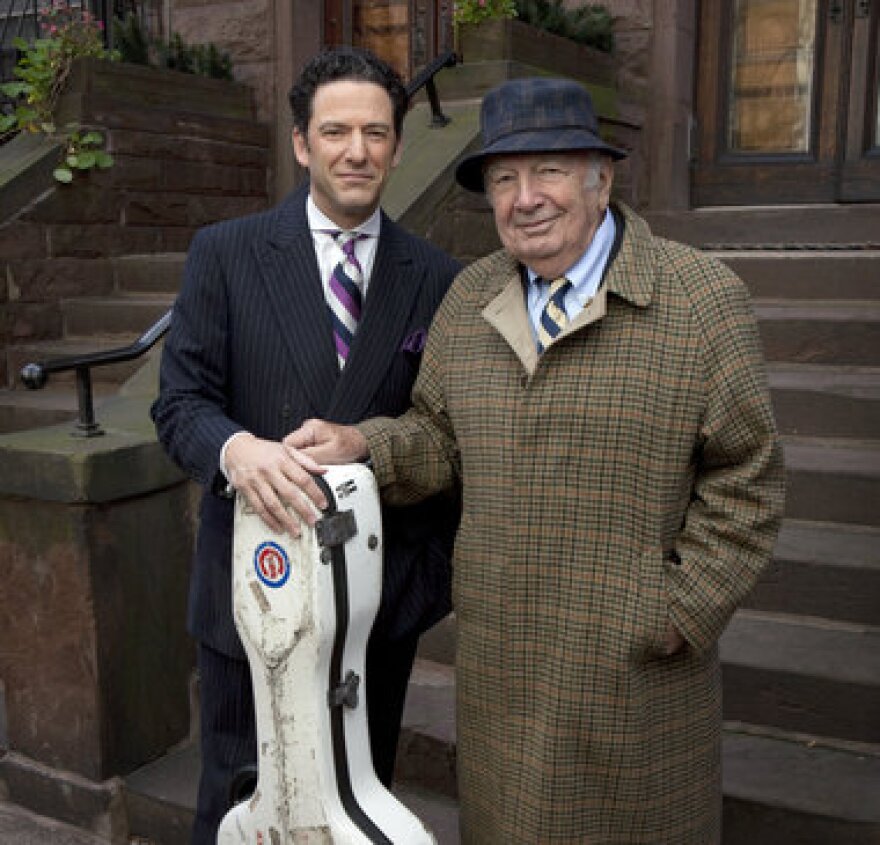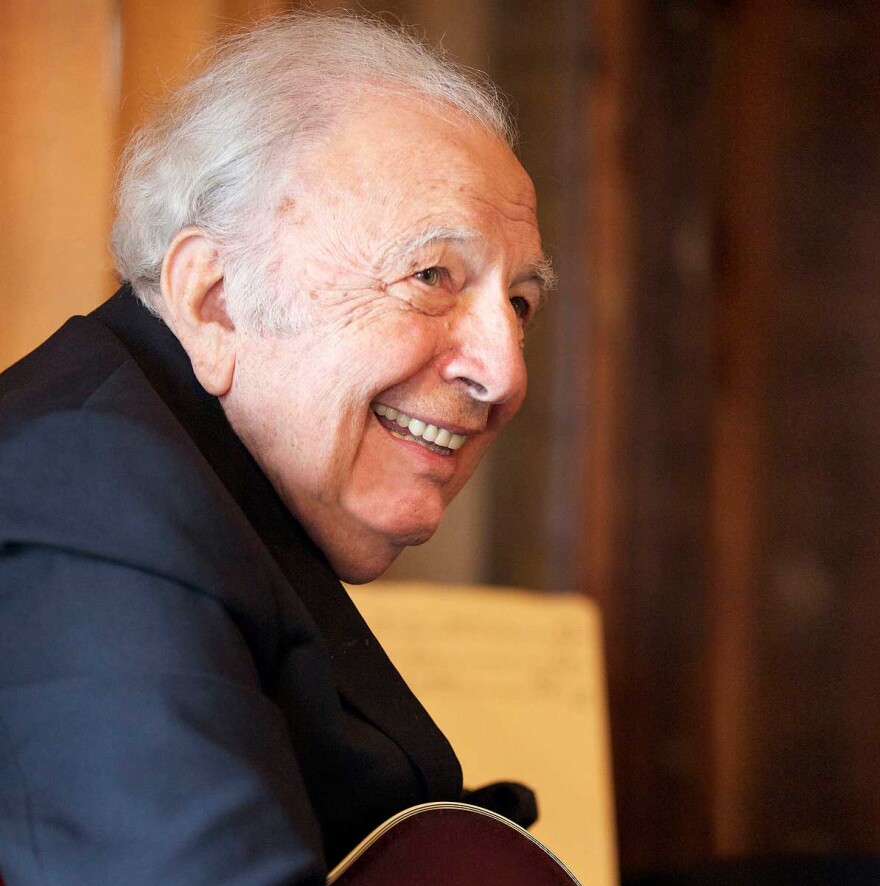You might think Pizzarelli is a lofty octogenarian superhero. He's an amusing, down-to-earth character who sounds less than half his age.
Many years ago, a young pianist named Bill Evans recorded an LP called Everybody Digs Bill Evans, one of those rare album titles that is forever memorable and also somehow a concise summation and mini-portrait of the artist himself.
If Bucky Pizzarelli, the much revered, 88-year-old grand master of the seven-string guitar were to make an album today with as apt a title, it would simply be called, Everybody Loves Bucky Pizzarelli. Fans and fellow guitarists (among the most demanding of all critics) love him for his classic rhythm guitar playing, his extraordinary chordal work, unobtrusive technical finesse, encyclopedic knowledge of the American Songbook, elegant sense of form and warm, melodic expressiveness that loathes anything the least bit showy or bombastic.
Pizzarelli began his career at 17 in 1943, going on the road with the renowned Vaughn Monroe Orchestra.
There’s also Pizzarelli's genial, easygoing, All-American personality. Even the nickname Bucky (he was christened John Paul), which was inspired by his cowboy loving father’s passion for the Old West, evokes romantic, homespun images of the American frontier. He is also somehow ego-free, despite his monumental achievements, and an impressive resume that includes associations with such luminaries as Benny Goodman, Buddy Rich, Stephane Grappelli, Ray Charles, Frank Sinatra, and Tony Bennett, and performances in prestigious venues from Carnegie Hall to the White House.

Pizzarelli, a famously sunny jazz patriarch, presents his affable stage presence and bright, breezy, yet classically articulated artistry as he performs with the swinging, sensitive bassist/vocalist Nicki Parrott in an all-string trio setting at 8:30 pm on September 5 at The Side Door Jazz Club in Old Lyme.

Parrott, one of Australia’s blue-chip exports to the American jazz scene, appears often with Pizzarelli and was the bassist and vocalist of choice for ten years with his great friend and colleague, the legendary guitarist Les Paul. Parrott, who now lives in Brookfield and plays regularly with the tribute group, The Les Paul Trio, delights in every gig she has with Pizzarelli, a youthful Old Master who, she said, “has a lot to teach us all about showmanship, musicianship and great guitar chops too… and he is always smiling on stage!”
Graham Dechter, the sensational, young straight-ahead guitarist and the third member of Parrott’s trio for the Side Door session, calls Pizzarelli, who’s old enough to be his great-grandfather, “one of my all-time musical heroes and one of my biggest influences as a guitarist.”
With Dechter, as with so many Pizzarelliphiles, it’s not just the guitarist’s warm, spirited music, but also his charming, friendly presence. “It’s always a distinct honor and a major learning experience to be able to play with him,” Dechter said, significantly, “and to be in his presence.”
Such high praise doesn’t seem to move Pizzarelli all that much, one way or the other.
Most certainly not as much as having the time to practice a favorite classical guitar piece for several hours in the morning in his home where he lives quite happily with his wife of 60 years, Ruth, a former nurse. Nor could any amount of praise match the sheer joy he experiences whenever he goes down into his basement where, like his good buddy Tony Bennett, he loves to relax while painting at his easel with his brushes and acrylics, portraying everything from pastoral scenes to—a bit surprisingly for such a cheerfully optimistic personality—depictions of infamous disasters like the sinking of the doomed Titanic in the North Atlantic Ocean, or the ill-fated German airship The Hindenburg engulfed in flames over Lakehurst, New Jersey.
When you call Pizzarelli at his home in Saddle River, New Jersey, you might expect you’d be talking to a lofty octogenarian superhero at the other end of the line. Instead, you’re chatting with an amusing, down-to-earth, youthful character who sounds less than half his age on the phone.
Asked what his secret is for such an amazingly long-running, successful career, Pizzarelli said, in a typically self-effacing remark, “I don’t know. I just keep doing the same thing that I’ve been doing for 70 years.”
Humor is an important facet of his persona. Ask him, for example, what accounts for the disproportionate number of outstanding guitarists who come from New Jersey, his home state, and he replies with a George Burns-like quip: “It’s because we couldn’t afford pianos.”
While he’s terrible at blowing his own horn, he loves to talk about music in general and guitars in particular, especially his beloved seven-string guitar, the instrument long identified with his signature style playing.
Pizzarelli loves to talk about his beloved seven-string guitar, the instrument long identified with his signature style playing.
Here’s how he discovered the seven-string guitar, the key to his musical seventh-heaven as a consummate soloist and session player who always seems at home wherever he plays. "One of my heroes," he said, "was guitarist George Van Eps, a native of Plainfield, New Jersey, who was with the Paul Weston Orchestra on the West Coast. I always knew his work, but he came out with an album with his seven-string guitar in 1955, and I went crazy when I heard it. The extra string gives you extra low notes. You can play bass lines, and you can actually play piano music on the guitar. That’s why they call it a "lap piano."
Pizzarelli is, of course, enormously proud of and only too happy to talk about his two musical sons, John, who has become an acclaimed, sophisticated crooner and, like his Dad, a smooth sailing seven-string guitarist, and Martin, an upright bassist who frequently collaborates with his celebrated brother and is a fine musician in his own right. Both sons are a product of the loving, tight-knit Pizzarelli home, which was frequented by such jazz giants as Goodman and the upright bassist Slam Stewart, one of Martin’s early heroes.
“Watching John’s career,” Pizzarelli said with a note of wonderment and pride in his voice, “has been like watching Sinatra grow up.”

Whatever success the Pizzarelli father and sons have enjoyed, Bucky said, the family tradition for talented musicianship actually originates with two of his uncles, Peter and Bobby Dominick. Accomplished banjo and mandolin players, they were an early inspiration that set young Bucky down the path towards music and a career that transformed into an ongoing holiday for strings.

“Bobby, the younger uncle, played with a lot of the big bands of the day like Buddy Rodgers, Clyde McCoy and Raymond Scott, and was forever showing me a lot of stuff. Bobby also played with Joe Mooney, a once well-known blind musician from Paterson, New Jersey, where Bucky grew up, who played accordion and organ.
“My uncles bought me a guitar when I was nine or ten, and that was it. Well, there had been a ukulele before that, but it was just a sideshow,” he said.
Many years later when Pizzarelli was a sideman in the band on “The Tonight Show” with Johnny Carson that early uke training stood him in good stead when, in a bizarre moment in network history, the band accompanied entertainer Tiny Tim on the night the ukulele-playing, falsetto-warbling singer married Miss Vicki on the show as 40 million viewers tuned-in. Before the matrimonial knot was tied, Pizzarelli tuned-up the strings for Tiny Tim’s ukulele.)
A self-taught striver, Pizzarelli began his career at 17 in 1943, going on the road with the renowned Vaughn Monroe Orchestra. Besides Monroe, a then famous baritone singer, the orchestra’s personnel included arranger Don Costa, who later wrote classy charts for Frank Sinatra, and the harmonica wizard and arranger Richard Hayman, who would score a mega-hit in 1953 with his version of Ruby from the film of the same name.

After a stint abroad in the military in World War II, Pizzarelli returned home to the States as the once seemingly invincible Big Band Era was fizzling out. Luckily, he hooked up with studio work in the 1950s—a Golden era for versatile, highly skilled session players like Pizzarelli and such close colleagues as guitarists Tony Mottola (another Jerseyite), Arthur Ryerson (father of the noted flutist Ali Ryerson) and Barry Galbraith, and a then also omnipresent pianist named Lou Stein.
“When the big bands broke up and the big band business was dying, I figured that was the end of my musical life,” Pizzarelli said.
But following up on a tip from a violin player at a radio gig, he checked out an opening at NBC, winding up with one the first of many plum studio gigs, playing for a year in the band for Kate Smith’s TV variety show. TV and recording studio gigs abounded back then as the economy boomed in post-World War II Manhattan. You had to have your guitar at the ready, grab a cab when called and speed through crosstown traffic to the next gig and later the one right after that.
“When the studio thing started to happen, we were doing three record dates a day for a whole week, and it was like from ten to one, two to five, and seven to ten. You had to be available all the time. That was the most important thing,” he said.
Since then there have been numerous successes, including his long, congenial collaboration with Goodman, acclaimed recordings and countless performances worldwide. Among the triumphs were many empathetic chamber jazz collaborations, including with such highly esteemed guitarists as George Barnes and Howard Alden, among others, as well concerts and recording dates with his sons and his daughter-in-law, John’s wife, the singer/songwriter Jessica Molaskey, a native of Wolcott.

Even today at 88, there’s no letup for the string maestro, except when he’s easing up at the easel with his acrylics. There’s always the next gig, always the unending urge to play every single day both at home and away. There’s always something new to learn, always something old to review, he said of his happily embraced daily regimen.
His basic pragmatic advice to youngsters who want to earn a living making music is to learn lots of songs. “You’ve got to know the American Songbook. Songs like “Night and Day,” “Tea for Two”… If you don’t know those songs, you can’t work,” he said.
As for setting the bar for himself, he said: “I just try to play the right chords. If you don’t do that, you’re out.”
The Nicki Parrott Trio with Bucky Pizzarelli plays at 8:30 pm on September 5 at The Side Door Jazz Club at 85 Lyme Street in Old Lyme. Tickets: $38.50. Information: (860) 434-0886.
Lee Konitz Ignites Firehouse Series

Firehouse 12 launches its 2014 Fall Jazz Serieson September 12 with a high-powered performance by the noted German-born saxophonist Ingrid Laubrock. Adding a feather to its cap, the distinguished improvised music series concludes its weekly Friday night runs with an especially grand flourish on December 12 by presenting the iconic alto saxophonistLee Konitz, a classic exemplar of innovative and creative art for many decades.
The ambitious series also features debut performances at Firehouse 12 by the pioneering, heavyweight British free jazz saxophonist Evan Parker and percussionistMike Pride. Among Firehouse favorites back for encores are the rising, young guitarist Mary Halvorson for two not-to-be-missed solo sets; cellist Daniel Levin, pianist Myra Melford and guitarist Michael Musillami.
Here’s the schedule: Ingrid Laubrock Quintet, September 12; Evan Parker/Joe Morris/Nate Wooley, September 19; Michael Gregory Jackson, September 26; Michael Musillami Trio + Kris Davis, October 3; Manuel Valera Trio, October 10; Mike Pride’s from Bacteria to Boys, October 17; and The Wee Trio, October 24.

Also, Joe McPhee/Daniel Levin/Chris Corsano, October 31;Mary Halvorson, November 7; Myra Melford and Ben Goldberg Duo, November 14; Andrea Parkins Duo, November 21; Jonathan Finlayson’s Sicilian Defense, December 5; and Lee Konitz Quartet, December 12.
Each concert features sets at 8:30 and 10:00 pm. Tickets for most events are $20.00 for the first set and $15.00 for the second set, and can be purchased at firehouse12.com, (203) 785-0468, or in person at the box office at 7:00 pm on the night of the show. A limited number of season passes good for admission to both sets of every concert are available for $225.00. Tickets for the Konitz performance are $30.00 for the first set, $25.00 for the second.
Please submit press releases on upcoming jazz events at least two weeks before the publication date to omac28@gmail.com. Comments left below are also most welcome.





